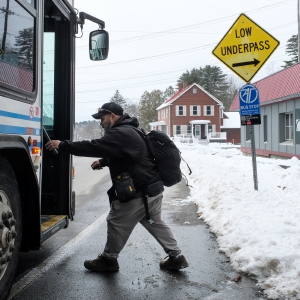Dartmouth researchers get a microscopic view of ticks
| Published: 05-09-2021 10:00 PM |
HANOVER — If you live in the Upper Valley, you’re probably well-acquainted with ticks and the risks they pose.
Images of the parasites at various stages in their lifespans — larva, nymph and adult, including male and female — taken using a scanning electron microscope at Dartmouth College show just how complex ticks are.
“None of us had seen the ticks before in such quite detail,” said Maxime Guinel de France, director of the Electron Microscope Facility at Dartmouth. He was particularly intrigued by the harpoon-shaped mouth on the larva, as well the legs that allow them to dig into a mammal’s skin.
In the pictures, the ticks — which had been previously preserved in alcohol and were provided by graduate student Kaitlin McDonald — have a metallic sheen. This is because they were dehydrated, then coated with a thin layer of metal in a process called sputter coating before being put in the microscope. Once the ticks are in the microscope, scientists can examine them up close. Guinel de France said the adult ticks are approximately 3 millimeters long and 1.3 millimeters wide, not counting the legs. They were put under the microscope in February and are now being shown to a wider audience.
The pictures are being used in lesson plans for Dartmouth Rural STEM Educator Partnership, which was created from a five-year, $1.3 million grant from the Science Education Partnership Award from the National Institute of General Medical Sciences to bring science education programs to middle school science teachers and students in rural areas. The schools involved are Claremont Middle School, Indian River Middle School in Canaan, the Barnet (Vt.) Middle School and the Tunbridge Central School.
“In rural New England, middle school science education, high school even, is very under-resourced,” said Roger Sloboda, a biology professor at Dartmouth who is working on implementing the program. The team has worked with educators at the schools involved to develop lesson plans since 2019. Before the COVID-19 pandemic began, graduate students were going into the schools to work on experiments with students. One of them involved students putting their fingerprints on Petri dishes after rubbing their fingers on different surfaces, which they would later examine under microscopes.
“They’re thrilled that their students have really, really enjoyed the hands-on activity and grown their own bacteria from their fingers,” Sloboda said. “Evidence shows that hands-on experiments, where kids can set up an experiment, not just read about one … is much more meaningful as a learning experience. It drives the process home more than just reading about it in the book.”
Once the pandemic took hold, graduate students could no longer work with kids in the schools. Instead, the team pivoted to help the teachers to create remote lesson plans, such as the one involving the tick images which are included in a lesson titled “Ticks: How Climate Change Affects My Health” which is directed at sixth-grade students. The materials are available to all educators, regardless of whether their school is involved in the program, at sepa.host.dartmouth.edu. There is also a forum educators can sign up for to talk about different lesson plans and topics.
Article continues after...
Yesterday's Most Read Articles
 Upper Valley winter shelters kept dozens warm and dry
Upper Valley winter shelters kept dozens warm and dry
 Former principal of South Royalton School released from prison
Former principal of South Royalton School released from prison
 Owner of Friesian horse facility ordered to pay care costs for seized animals
Owner of Friesian horse facility ordered to pay care costs for seized animals
“The ticks were more specific because we’re catering to rural New England where ticks are an issue so we wanted to have the topic to be somewhat relevant to what students are aware of,” said Sidhartha Jandhyala, who is one of 10 graduate students involved in the Dartmouth Rural STEM Educator Partnership.
Jandhyala, a fifth-year student pursuing a doctorate at Dartmouth’s Thayer School of Engineering, created a short YouTube video to accompany the lesson.
“I was actually really shocked when I saw those images. I didn’t expect that many details, especially that harpoon mouth,” Jandhyala said. “I was also very surprised at some of the differences between the males, females and the different stages of ticks.”
In the video, Jandhyala explains the life stages of a tick before detailing how the images were taken and describing each one. The video concludes with a short quiz and encouraging kids to be aware of ticks, which can carry Lyme disease and other pathogens, when they are outside.
“Hopefully these experiments will spark that curiosity in students and they’ll go on to be the future scientists that we need,” Jandhyala said.
Liz Sauchelli can be reached at esauchelli@vnews.com or 603-727-3221.

 Hartland voters successfully petition for school budget revote
Hartland voters successfully petition for school budget revote 
